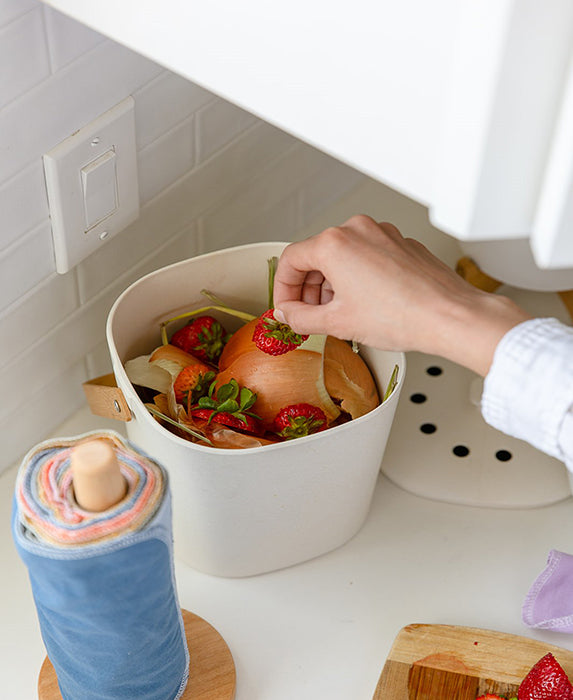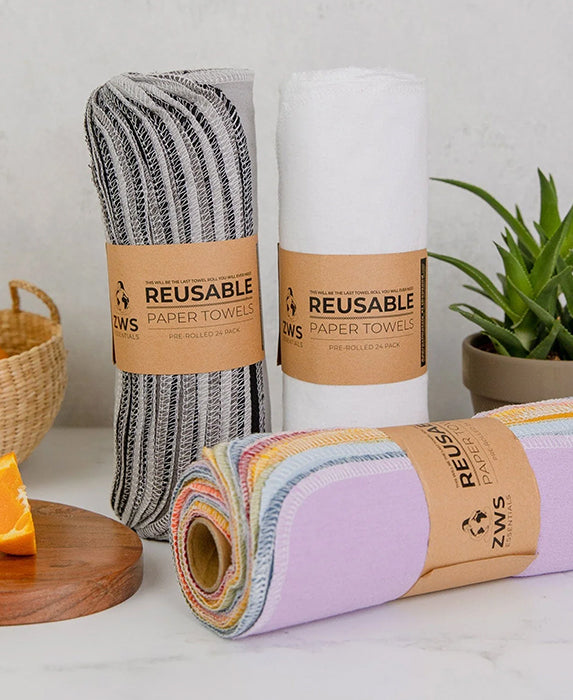We are all consumers, it’s unavoidable! “Consumerism” is what encourages us to purchase (or consume) goods and services, and it’s all around us. Our world is full of advertisements encouraging us to consume without thinking about the possible repercussions. But, we can all take steps to make sure we are more conscious when consuming – which means putting people, and our planet, ahead of profit.
There are billions of other people in the world purchasing wasteful products, and it all adds up. We’ve reached a point where the Earth can’t keep up with how much and how fast we consume goods and utilize resources.
All of this is scary, but the best way to combat fear and anxiety is to actively do something about it! The good news is that we have the power to change the way our consumer culture functions simply through our buying habits! You can still purchase products without contributing to the cycle of waste and pollution. This is such a powerful idea, especially because the Earth is in need of our help – now more than ever! Read on to learn what it means to be a conscious consumer, and how you can work towards being one!
What you’ll learn:
- The problem with current practices around linear consumption, and the concept of circular systems and their benefits
- What is means to be a conscious consumer
- Conscious consumerism as a tool for systematic change
- How to be a conscious consumer
Linear Consumption
Consumerism is often seen as one of the sole problems contributing to environmental destruction. In reality, it’s not consumerism that has been our downfall – but the way we consume. More specifically, linear consumption, or the linear economy, and how it’s become the norm in our world. The consequences of linear consumption have been so far removed from us as buyers for so long, leading to negative social and environmental impacts.
So what exactly is linear consumption? Basically, it’s purchasing things to be used a handful of times and then thrown away. Linear consumption doesn’t focus on – or pay attention to – reusing or recycling used products. This makes it the least sustainable way to consume resources and products.
Because we know that there’s a constant stream of products on the shelves, we treat the items we buy with little importance. Moreover, it doesn’t help that most industries are only concerned with making money, causing them to ignore potential environmental impacts when producing, transporting, and selling their products. This lack of understanding around resources, how long products last, and the energy it takes to create products has led to a linear economy, rather than a circular one. We’re producing an extreme amount of waste through this model of linear consumption. Landfills are one of the largest contributors to soil and water contamination, yet 80% of the garbage in landfills contains materials that could have been recycled or composted!
Circular Systems
The concept of a circular system (or circular economy) is that unwanted products and materials can be salvaged and made into new items down the line. This means that less waste is created in the process!
Most processes in nature are circular, and that is no coincidence – circular systems are the most efficient and sustainable systems that exist! The most basic example of a circular system within nature is decomposition. This is where every part of a plant or animal is returned back to the Earth in the form of nutrients that will help other plants and animals flourish in the future. We could learn a thing or two from mother nature and her circular systems… It could potentially be applied to the consumption of all things; food, resources, clothing, beauty products, and even energy!
Circular economic systems are focused on recycling, repairing, reusing, and revamping old products and resources so that as little as possible ends up as trash. There are three key things that really define a circular economy:
- Designing out waste and pollution
- Keeping products and materials in use as long as possible
- Regenerating natural systems
These keep sustainability in mind as well as economic profits; when you are reusing materials it can save a lot of time and money. This means we can create a healthy and thriving economy based on circular economic systems that protect the health of our planet. We don’t have to give up the products we love, and the environment doesn’t need to suffer because of it!
So how do we make this happen? We, as consumers, make this possible by demanding things to change through our purchasing decisions. When we support brands that are paving the way for sustainability, the market notices and adjusts accordingly!
Conscious Consumerism
Conscious consumerism has a lot to do with circular systems. Conscious consumerism is the practice of understanding the consequences of your shopping habits and then making the necessary changes in order to practice a more sustainable lifestyle.
Conscious consumers who care about the planet want to make sure their hard-earned money goes towards companies with the same interests and values! This can be hard because, in order for someone to truly practice conscious consumerism, they need to understand much more about the products they are buying than the average consumer currently does. Knowledge and understanding are the tools you will need to become a conscious consumer!
This doesn’t mean you have to spend all your time researching products and learning everything about the harmful consequences because that would be impossible! Rather, all you need to do is change the types of products you shop for and where you shop. Following influencers and brands (like EarthHero!) who have already done the research is an excellent start to gain sustainable tips on how to make simple life changes that will improve our world.
Voting with Your Dollar
We all know that money is power and this is what makes conscious consumerism so effective. We live in an age where industries sadly tend to care mostly about profit and power. But, just as giving money to nonprofit organizations helps them continue to do their positive work; the same rule applies when shopping for any product! When you spend money on anything, you are saying you support that brand, its practices, and you want them to stay in business.
Voting with your dollar is the single most significant way to shift the market because consumers are the dictators of the market! It is hard to see an economy in which consumerism is not present. This is exactly why EarthHero was founded, in order to give consumers alternative product options so your purchasing power can be used to support ethical brands that stand up for the planet. Keep reading for some easy tips on how to become a conscious consumer!
How-To Be a Conscious Consumer
It may seem daunting, but becoming a conscious consumer can actually be quite simple. Here are some super easy ways to change your buying habits to be more ethical, sustainable, and mindful!
Produce and Meats
If you have access and ability, buy organic produce and meats! When buying organic products, that means that less harmful pesticides, antibiotics, or preservatives were used. The pesticides used to threaten the health of pollinators, such as bees, which are responsible for producing every third bite of food we eat! Additionally, agrichemicals used in non-organic grow operations harm topsoil (the soil where plants grow) and can cause soil to become unable to support new plant growth. Plus, just like supporting any ethical brand, supporting organic farmers indicates to the market that organic produce and meats are what consumers want, and the markets will shift to support them.
Bathroom Essentials
Self-care and beauty products can be some of the most wasteful in your home since they are often packaged in tons of unnecessary plastic. Here are some eco-friendly must-haves for the bathroom: bamboo toothbrush, stainless steel razor, compostable loofahs, & shampoo and conditioner bars! Another fantastic tip is to make sure that you are buying either recycled content or FSC Certified paper products like toilet paper and tissues. Roughly 50 soccer fields worth of trees are cut down every single minute, so recycled or sustainably sourced paper products are a more conscious alternative!
Zero Waste Kitchen
The kitchen is another place in the house were a large amount of waste is created- most of it being food waste. Did you know that globally about 1/3 of the food produced for human consumption is lost? That is 1.3 billion tons of food waste! An even more staggering statistic is that consumers in developed countries waste as much food as the entire net food production of all of sub-saharan Africa (222 million tonnes). But, composting can help safely dispose of food waste! Beyond food waste, ensure you’re also purchasing reusable, durable food storage containers – not single-use plastic items like saran wrap or plastic bags. Not only do reusable food storage containers and bags reduce the amount of plastic used in the kitchen, they will help your food stay fresh much longer! Many people do not know that plastic actually causes food to degrade much faster, so housing your meat and produce in silicone, glass, or stainless steel is the best option! Here are some sustainable products everyone needs in the kitchen: reusable food storage containers, beeswax wrap, reusable snack bags, reusable produce bags, biodegradable sponges and dish brushes, and a bar of castile dish soap!
You Got This
These are just a few ways to become a more conscious consumer, and some easy swaps you can make in your home. But… there is so much more you can do! The moral of the story is just to be aware of what you are buying and the repercussions of that purchase. Once we become aware and arm ourselves with knowledge, we can truly fight the linear consumption system that hurts our planet. Support brands that have missions aligned with yours, do a little extra research when it comes to materials and packaging, and above all – stay positive! Shifting our global economy won’t happen overnight, but with persistent and targeted changes. To explore some conscious brands we support, click here!
This blog was originally published August 10, 2020 and was last updated on October 27, 2022.









